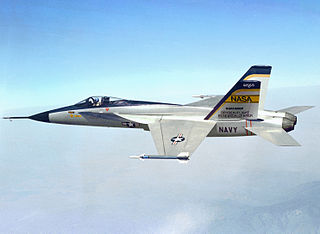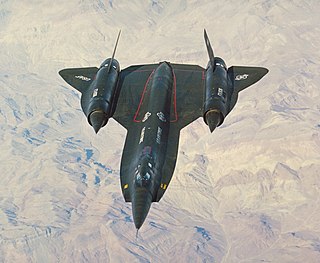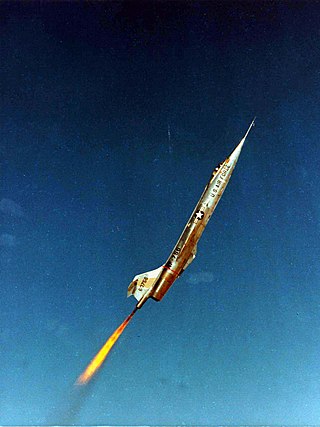
The McDonnell XF-88 Voodoo was a long-range, twinjet fighter aircraft with swept wings designed for the United States Air Force. Although it never entered production, its design was adapted for the subsequent supersonic F-101 Voodoo.

The Northrop YF-17 was a prototype lightweight fighter aircraft designed by Northrop aviation for the United States Air Force's Lightweight Fighter (LWF) technology evaluation program. The LWF was initiated because many in the fighter community believed that aircraft like the F-15 Eagle were too large and expensive for many combat roles. The YF-17 was the culmination of a long line of Northrop designs, beginning with the N-102 Fang in 1956, continuing through the F-5 family.

The Northrop/McDonnell Douglas YF-23 is an American single-seat, twin-engine, supersonic stealth fighter aircraft technology demonstrator designed for the United States Air Force (USAF). The design was a finalist in the USAF's Advanced Tactical Fighter (ATF) demonstration/validation competition, battling the Lockheed YF-22 for the full-scale development contract. Two YF-23 prototypes were built.

The Lockheed YF-12 was an American Mach 3+ capable, high-altitude interceptor prototype, developed and manufactured by American aerospace company Lockheed Corporation.

The Rockwell-Messerschmitt-Bölkow-Blohm X-31 is an experimental jet aircraft designed to test fighter thrust vectoring technology.

The General Electric F110 is an afterburning turbofan jet engine produced by GE Aerospace. It was derived from the General Electric F101 as an alternative engine to the Pratt & Whitney F100 for powering tactical fighter aircraft, with the F-16C Fighting Falcon and F-14A+/B Tomcat being the initial platforms; the F110 would eventually power new F-15 Eagle variants as well. The engine is also built by IHI Corporation in Japan, TUSAŞ Engine Industries (TEI) in Turkey, and Samsung Techwin in South Korea as part of licensing agreements.

The Bell X-14 is an experimental VTOL aircraft flown in the United States in the 1950s. The main objective of the project was to demonstrate vectored thrust horizontal and vertical takeoff, hover, transition to forward flight, and vertical landing.

The North American F-107 is North American Aviation's entry in a United States Air Force tactical fighter-bomber design competition of the 1950s, based on the F-100 Super Sabre. It incorporated many innovations and radical design features, notably the over-fuselage air intakes. The competition was eventually won by the Republic F-105 Thunderchief, and two of the three F-107 prototypes ended their lives as test aircraft. One is on display at the National Museum of the United States Air Force and a second at Pima Air and Space Museum.

The Ryan X-13 Vertijet was an experimental tail-sitting vertical take-off and landing (VTOL) jet aircraft built by Ryan Aeronautical and flown in the United States in the 1950s. The main objective of the project was to demonstrate the ability of a pure jet to vertically take off, hover, transition to horizontal forward flight, and vertically land.

The General Dynamics F-16XL is a derivative of the F-16 Fighting Falcon with a cranked-arrow delta wing. It entered the United States Air Force's (USAF) Enhanced Tactical Fighter (ETF) competition in 1981 but lost to the F-15E Strike Eagle. The two prototypes were shelved until being turned over to NASA for additional aeronautical research in 1988. Both aircraft were fully retired in 2009 and stored at Edwards Air Force Base.

The General Dynamics–Grumman EF-111A Raven is a retired electronic-warfare aircraft designed to replace the EB-66 Destroyer in the United States Air Force. Its crews and maintainers often called it the "Spark-Vark", a play on the F-111's "Aardvark" nickname.

The McDonnell Douglas F-15 STOL/MTD is a modified F-15 Eagle. Developed as a technology demonstrator, the F-15 STOL/MTD carried out research for studying the effects of thrust vectoring and enhanced maneuverability. The aircraft used for the project was pre-production TF-15A (F-15B) No. 1, the first two-seat F-15 Eagle built by McDonnell Douglas, the sixth F-15 off the assembly line, and was the oldest F-15 flying up to its retirement. It was also used as the avionics testbed for the F-15E Strike Eagle program. The plane was on loan to NASA from the United States Air Force.

The Lockheed NF-104A was an American mixed-power, high-performance, supersonic aerospace trainer that served as a low-cost astronaut training vehicle for the North American X-15 and projected Boeing X-20 Dyna-Soar programs.

A large number of variants of the General Dynamics F-16 Fighting Falcon have been produced by General Dynamics, Lockheed Martin, and various licensed manufacturers. The details of the F-16 variants, along with major modification programs and derivative designs significantly influenced by the F-16, are described below.

The General Dynamics–Grumman F-111B was a long-range carrier-based interceptor aircraft planned as a follow-on to the F-4 Phantom II for the United States Navy (USN).

The Kratos XQ-58 Valkyrie is an experimental stealthy unmanned combat aerial vehicle (UCAV) designed and built by Kratos Defense & Security Solutions for the United States Air Force's Low Cost Attritable Strike Demonstrator (LCASD) program, under the USAF Research Laboratory's Low Cost Attritable Aircraft Technology (LCAAT) project portfolio. It was initially designated the XQ-222. The Valkyrie completed its first flight on 5 March 2019 at Yuma Proving Ground, Arizona.
The Skyborg project is a United States Air Force Vanguard program developing unmanned combat aerial vehicles intended to accompany a manned fighter aircraft. As of 2020, contracts have been awarded to Boeing, General Atomics, Kratos Unmanned Aerial Systems and Northrop Grumman.

Collaborative combat aircraft (CCA) is a US program for unmanned combat air vehicles (UCAVs) that is considered broadly equivalent to a loyal wingman. CCAs are intended to operate in collaborative teams with the next generation of manned combat aircraft, including sixth-generation fighters and bombers such as the Northrop Grumman B-21 Raider. Unlike the conventional UCAVs, the CCA incorporates artificial intelligence (AI), denoted an "autonomy package", increasing its survivability on the battlefield. It is still expected to cost much less than a manned aircraft with similar capabilities. The US Air Force plans to spend more than $6 billion on its CCA programs from 2023 to 2028. The success of the CCA program may lessen the need for additional manned squadrons.
A loyal wingman is a proposed type of unmanned combat air vehicle (UCAV) which incorporates artificial intelligence (AI) and is capable of collaborating with the next generation of manned combat aircraft, including sixth-generation fighters and bombers such as the Northrop Grumman B-21 Raider. Also unlike the conventional UCAV, the loyal wingman is expected to be capable of surviving on the battlefield but to be significantly lower-cost than a manned aircraft with similar capabilities. In the US, the concept is known as the collaborative combat aircraft (CCA).

The Convair NC-131H Samaritan, also known as the Total In-Flight Simulator, was originally a C-131B aircraft that underwent conversion by the United States Air Force in the late 1960s. It was transformed into an in-flight simulator specifically developed to study aircraft handling characteristics. The NC-131H made its maiden flight in 1970.



















